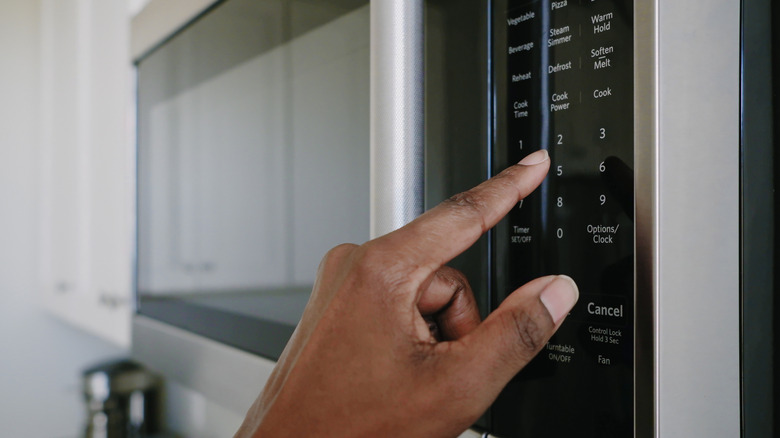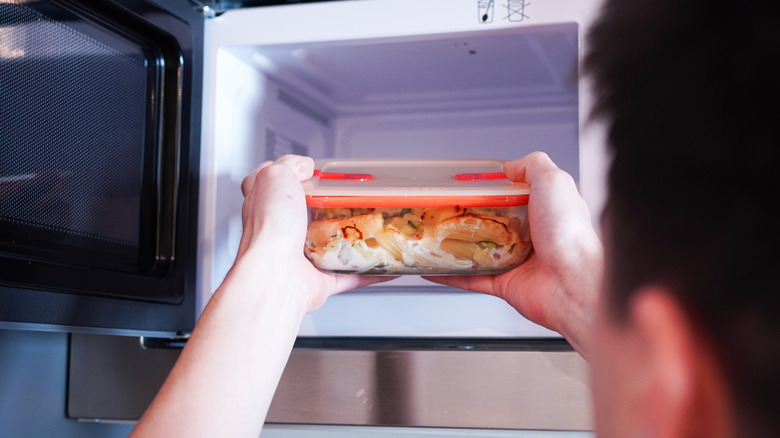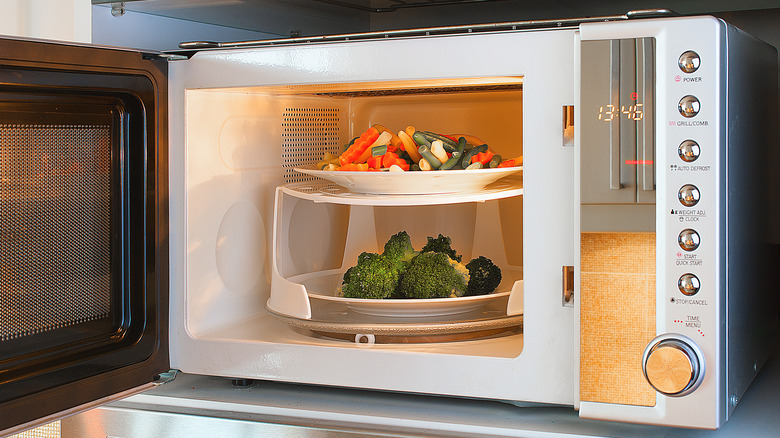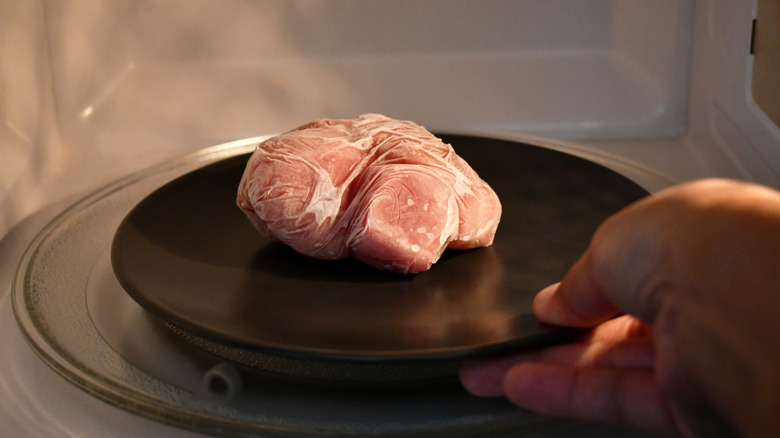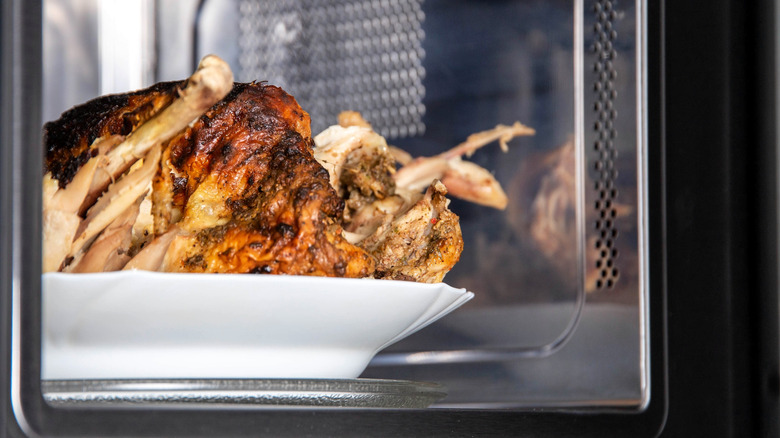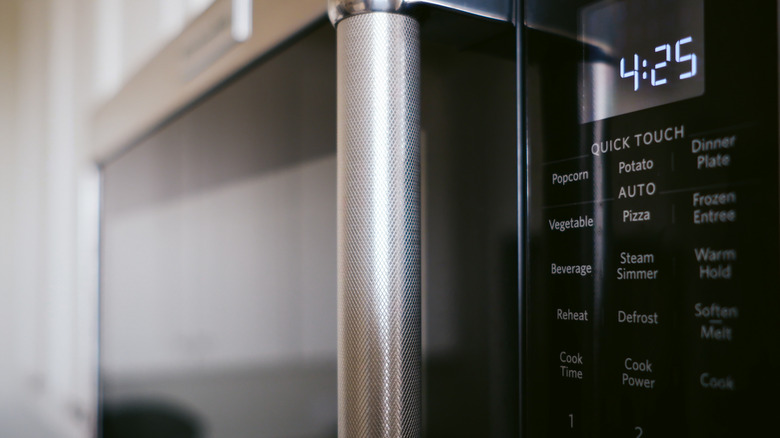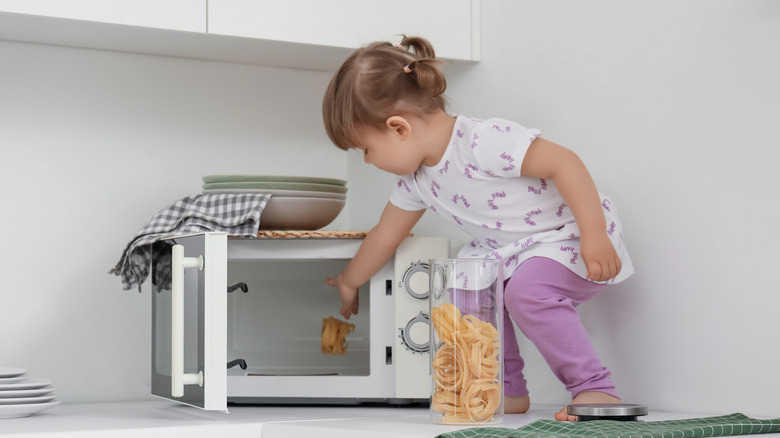10 Microwave Settings You Should Use More Often
Every year, thousands of new kitchen gadgets appear at industry trade shows. Some earn a place on store shelves, some become legitimate hits, but most simply disappear. Yet, every generation brings a tool or two that's genuinely revolutionary. Consider the arrival of cookstoves, for example, as a replacement for open-hearth cookery. Then came electric and gas stoves, replacing wood and coal, and giving cooks and bakers the ability to directly control heat for the first time. We don't really think about those things anymore, because they're so familiar. The same holds true for microwave ovens, which have been around since the post-war years and common since the '70s. They're inarguably just as revolutionary, in their way. How often do we use one in a day? How much of your nearest supermarket (or convenience store) is filled with microwaveable products?
Yet, for all their familiarity, few of us really use our microwave to its full potential. Even simple, low-priced models are capable of more than warming up your burrito, and the best microwave ovens often contain surprisingly sophisticated features and technology. Here are some microwave settings you should be using more often, and what they can do for you.
Power setting
Imagine how awkward cooking would be if your stove's cooktop only gave you the options of off and max. You'd be all set for boiling water or putting a good sear on a steak, but you wouldn't have a whole lot of range or versatility in your cooking. Yet, most of us do exactly that with our microwaves. They're set to use the maximum available power by default, and that's not always ideal. Rewarming something gently? Maximum. Thawing something frozen before you cook it? Maximum. Simmering delicate food? Maximum. It sounds silly when it's phrased that way, but it's what we do.
That's why most of us need to use the power level button on our microwaves. Small microwaves top out at 700 watts, and higher-end models can get up to 1100 watts. You just plain don't need that much power a lot of the time. If you're reheating something, for example, doing it at half-power takes a bit longer but does a better job. Other tasks might work best at ⅓- or ¼-power. It's the most important but (arguably) most ignored setting, and mastering it will go a long way to helping you get the best from your microwave.
Time cook
The time cook button is one that many microwaves don't have, because it's their default. You punch in whichever length of time is right for your food, and then push start. But often, microwaves are built around easy one-touch presets: Some will automatically give you one minute when you press 1, two minutes when you press 2, and so on. Others have buttons that give a minute or 30 seconds with each press.
If you have those buttons, it's all too easy to fall into the habit of just using them automatically, tapping out the close-enough version of whatever the cooking time for your food was supposed to be. It is a time saver, after all, and the microwave is all about convenience, right? Right? Well, that's fair enough as far as it goes. But the unfortunate reality is that foods don't all heat the same way in the same length of time, so it's not a "one size fits all" scenario.
There absolutely will be times when those seductively simple buttons can give you the correct cooking time, but it won't be every time. If you make a habit of using the time cook button (or its equivalent, however phrased) when necessary, you'll find that your food consistently comes out better. It's worth the extra couple of finger presses and a second or two of your time.
Reheat
Okay, this is one of the most common uses for the average microwave, and why not? They're good at it. But a number of microwave ovens have a reheat button, and if there's one on your microwave, it's worth using. Here's the thing: Microwaves heat unevenly, which is why most of us have had the experience of finding either cool or super-heated patches in food after we've reheated it. The reheat button is a way to address that issue. It uses a variety of sensors in the microwave's cabinet and some sophisticated algorithms to determine — from heat and humidity levels inside the microwave — when your food has fully reheated. Some models may even have multiple quick-reheat settings for different kinds of food.
Using this button, if you have one, goes a long way toward getting perfectly reheated food every time. You can help your own cause by always rewarming your food under a cover (which helps trap heat, as well as minimizing cleanup), and also by allowing your food a minute or two to rest after it's warmed. That way, the hotter spots can cool, and the cooler spots can warm, and your food will be more evenly heated.
Keep warm
Getting all the parts of a meal together on a plate at the same time involves some real skill and planning, as any restaurant cook quickly learns. Professionals have to work hard at getting it right, so it's only natural that home cooks struggle with this, too. It's not only a question of finesse or even convenience. Food safety depends on keeping your hot foods at above 140 degrees Fahrenheit — outside of the "danger zone," where unwelcome bacteria can begin to reproduce. At big holiday meals, for example, you may have side dishes tucked into a spare oven to keep warm, or prepare them separately in a slow cooker or pressure cooker for the same reason. Well, surprise! Your microwave may have that same function built in.
Not every microwave has this setting, but it's essentially a lower-power version of the reheat button we've previously talked about. In this case, the microwave's built-in algorithms apply just enough oomph to keep your food hot and ready for the table. It's a great convenience, especially for meals or other get-togethers that will involve a lot of dishes coming to the table at once.
Defrost by weight
Defrosting food is something not everyone gets right. A lot of people just leave meat or leftovers on the counter to thaw, which is one of the biggest mistakes you can make as far as food safety is concerned. It takes a long time for foods to thaw this way, so the outside will be at an unsafe temperature before the inside is fully defrosted.
The USDA has published guidance on thawing food safely, recommending (in this order) overnight thawing in the fridge, quick thawing in cold running water, or last-minute thawing in the microwave. Microwaves work well if you use them correctly, which — alas! — doesn't mean slapping a piece of meat on the turntable and pressing start. Most microwaves have an actual defrost button, and usually two: a quick defrost or time defrost, and a defrost by weight or auto defrost.
The defrost by weight option is your best choice, because it's more reliable than just guessing a time and hoping for the best (or checking frequently). It uses an algorithm to apply power judiciously in bursts, so the food thaws evenly without leaving frozen spots — or worse, cooked spots. You'll need to weigh the food if it's not in its original packaging, and it helps to flip it a time or two during the thawing process. Also, for food safety reasons, once you've thawed something in the microwave, it needs to be cooked (or reheated) immediately, rather than set aside for later.
Sensor cook
Not all microwaves have this, but if yours does, it's a feature you should be using. The sensor cook feature is implemented differently across microwave brands and models, but here's how it works in a broad sense. It's yet another application of the same sensors and algorithms used in the reheat and keep warm settings — but here, it's applied to actually cooking a food from start to finish in the microwave. The principle is the same; sensors in the microwave's cabinet keep track of temperature and humidity levels, and they can also judge from those when the food has finished cooking.
Some brands and models of microwaves provide a single sensor cook button, and will prompt you to enter the weight of the food or a cooking time. Others provide several pre-programmed buttons, set up for specific kinds of food. Some (like the popcorn and pizza buttons) are meant for reheating food, while others (like the baked potato button) are for cooking it completely.
Convection, bake, broil, or air fry
One of the longstanding complaints about microwave ovens is that they aren't good for all types of cooking. A particular issue is that they aren't good at crisping and browning, which is important for appearances (that whole "we eat with our eyes" thing), as well as texture and flavor.
A number of microwave models from various manufacturers address this by adding conventional or infrared heating elements, convection fans, and other sources of direct heat. If your microwave has these built in, it makes it significantly more versatile than a regular microwave. Using a combination of conventional microwave cooking and direct heat, you can cook or reheat meals more quickly, broil or bake, and even put a nice sear on a roast or a steak.
Some models treat those features as just a nice extra on what's primarily intended for use as a conventional microwave oven. Others are now designed and marketed as fully multifunctional appliances, combining the features of a microwave with those of a toaster oven, air fryer, or steamer. Opinions are divided on whether multifunction microwaves are worthwhile. Cynics say they just contain more things that can break, and they often don't compare well to separate standalone appliances. But if you have limited space, it's great to have all of those features in one (relatively) compact unit.
Multistage cooking
Higher-end professional kitchens sometimes contain what's called a combi-oven — a microprocessor-controlled steamer and convection oven that can be programmed to start (for example) a roast at a high temperature for browning, then drop it to a lower temperature for the rest of its cooking time, and finally hold it at a food-safe temperature until mealtime. Although they're considerably smaller and less costly, some higher-end microwaves are also capable of doing this kind of multistage cooking. It's worth looking in the manual to see if your microwave is one of them, because this is a really handy feature (it may also be called programmable cooking, stage cooking, or something along those lines).
If multistage cooking is available on your microwave, you could, for example, set it to defrost your food at one power setting, then cook it for varying lengths of time at multiple power settings (as/if needed), and then keep it warm for you until mealtime, all without any further hands-on fussing. Even if there are only a limited number of things you'd ordinarily choose to cook in your microwave, that's a great convenience.
Saved program settings
So, what could be better than the opportunity to program your microwave for multistage cooking? Well, how about the option of saving those settings, and the settings for other meals, so you have them at your fingertips for the future? That's where user-saved program settings come in.
Most microwaves already have some saved programs built into them at the factory in the form of those one-touch buttons for things like baked potatoes, pizzas, and popcorn. Making some buttons user-programmable is a big step up in functionality from those presets. If your microwave has that feature, you can create fully customized settings once, and then save them to reuse forever. It takes an already-convenient feature and makes it even more useful.
On some machines, those preset buttons may also be user-programmable. Ever wonder why most brands of popcorn say not to use the popcorn button on your microwave? It's because they don't all call for the same cooking time. If you have the option of reprogramming the button, you can set it for exactly the time your preferred brand uses. In fact, if popcorn is one of the big things you use your microwave for, you could even program three or four buttons to pop multiple brands for the correct length of time. It's totally up to you, which is the beauty of the feature.
Child lock
Childproofing is something adults love to complain about. In fact, it's fairly common to joke about getting the nearest kid to open a childproof package for you, because it's too tough for adults. That said, there are places where a child lock is important, and one of them is your microwave.
There's a point where kids are physically big enough and self-reliant enough to start feeding themselves, but not yet experienced enough to necessarily understand the corresponding risks and safety precautions. If they boil water in the microwave, for example, there's a risk of them scalding themselves while getting it out (and liquids can become superheated in the microwave, increasing the degree of damage they can do).
Kids of a certain age might also put a toy or other object into the microwave "just to see." Depending on what the toy or object is, that can cause a nasty mess, toxic fumes, or — if the object contains metal — arcing that could damage your microwave or even start a fire. Even a responsible youngster might absent-mindedly microwave a fork on their plate or a spoon in their bowl, with similar results. The child lock can be an irritation and an inconvenience for the household's adults, but if you have children of that age, it's a small price to pay for safety.


